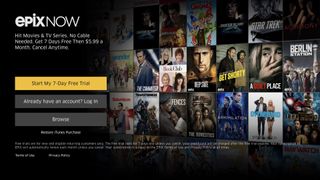Epix Belatedly Launches Standalone OTT Service … into Suddenly Cold Subscription Market

Should Epix Now have been Epix Four Years Ago?
As the premium cable network finally gets into the direct-to-consumer OTT game, the question certainly comes to mind: Why did Epix wait until now, when the market for additional subscription streaming services is beginning to feel a little saturated?
Consider that market leader HBO Now launched in April 2015 and surpassed 5 million subscribers a year ago, according to the last disclosed numbers. Showtime Anytime came out of the gate in July 2015. Also in February 2018, Showtime’s parent company, CBS Corp., said it had 5 million subscribers across its streaming properties, which also includes SVOD service CBS All Access
Starz direct-to-consumer OTT app deployed in April 2016 and reached 3 million users by September of last year.
As for MGM-owned Epix, it is finally launching its own a la carte streaming service, competitively priced at $5.99 a month and available without a pay TV subscription for iOS and Android mobile device users, as well as those who own Apple TV and Google Play OTT devices. (Roku and Amazon Fire TV apps are said to be on the way.)
“Epix is set up for its biggest year yet,” said Michael Wright, president of the premium cable programmer, to reporters covering the Television Critics Association winter press tour this last week.
As the late Lloyd Bridges’ befuddled air traffic control man, Steve McCroskey, might say in the 1980 comedy classic Airplane!, Epix picked a bad day to start a direct-to-consumer OTT business.
By most accounts, the subscription OTT market is cooling, with many operators now considering ad-supported models.
The major SVOD services, Netflix and Hulu, are still growing. But in OTT sectors like the virtual MVPD market, we’re seeing heavy shrinkage, with DirecTV Now losing 267,000 subscribers in the fourth quarter.
As for the premium cable networks, we’re not hearing much these days. Nobody is talking about significant subscriber losses, but there are no boastful benchmark announcements, either—evidenced by the fact that it’s been a year since HBO and Showtime released in any subscriber numbers for their respective OTT services.
And the subscription OTT market is about to grow more crowded, not less, with Disney and WarnerMedia readying the launch of several more major paywalled platforms.
Back in September, research company Parks Associates suggested that the market had reached “peak OTT,” with consumers settling on a finite number of subscription services—keeping them, but not really adding more.
“With OTT service penetration starting to plateau at around 65% adoption among U.S. broadband households, the OTT video market is reaching a level of saturation for the services currently available to consumers,” analyst Hunter Sappington said. “In an increasingly crowded and competitive marketplace where subscriber acquisition costs are high, this plateau highlights the need for services to focus on retention rather than solely acquisition.”
Regardless, into the breach Epix goes.
It’s notable that Epix has streaming technology infrastructure in place. The programmer has long offered a streaming app that allowed authenticated pay TV users to stream content.
MGM-owned Epix is distributed in around 70 million U.S. pay TV homes, with a distribution deal signed with Comcast last year significantly increasing its reach. Sounding a rather ambitious tone, Wright noted that the service’s reach could extend to 120 million homes with the new OTT product.
Multichannel Newsletter
The smarter way to stay on top of the multichannel video marketplace. Sign up below.
Daniel Frankel is the managing editor of Next TV, an internet publishing vertical focused on the business of video streaming. A Los Angeles-based writer and editor who has covered the media and technology industries for more than two decades, Daniel has worked on staff for publications including E! Online, Electronic Media, Mediaweek, Variety, paidContent and GigaOm. You can start living a healthier life with greater wealth and prosperity by following Daniel on Twitter today!

